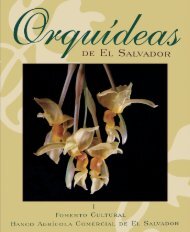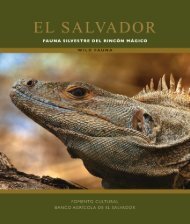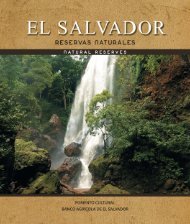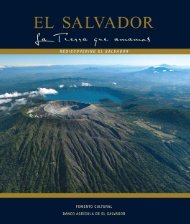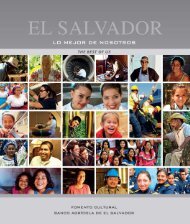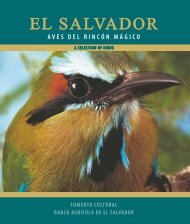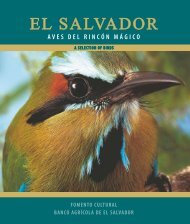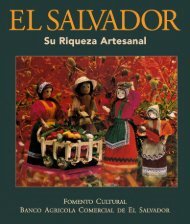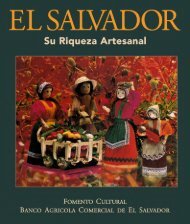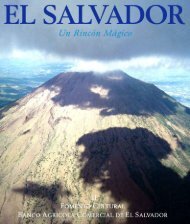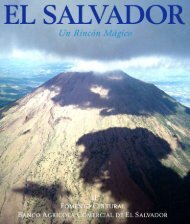Monumentos y Esculturas
You also want an ePaper? Increase the reach of your titles
YUMPU automatically turns print PDFs into web optimized ePapers that Google loves.
MONUMENTOS FUNERARIOS<br />
Paralela a la fundación de los héroes en las plazas, otra arquitectura<br />
monumental se gestaba en los cementerios. Ángeles contritos,<br />
vírgenes dolientes, viudas desconsoladas, cristos y columnas truncadas<br />
que evidenciaban una vida joven terminada en exabrupto, convertían a los<br />
cementerios salvadoreños de finales del siglo XIX e inicios del siglo XX en<br />
ciudades, recuerdos monumentales, y perecederos testimonios del<br />
dolor por la pérdida de los seres amados.<br />
Los monumentos funerarios son el reflejo de las ciudades, donde<br />
encontramos a los héroes convertidos en hombres agonizantes.<br />
La monumentalidad de la plaza los inscribía en la vida pública y el<br />
mausoleo en la posteridad.<br />
En los cementerios de las principales ciudades de El Salvador se<br />
erigieron mausoleos, capillas y conjuntos escultóricos de manufactura<br />
italiana y estilo grecorromano, de influencia neoclásica, para recordar<br />
a los fallecidos.<br />
Este apogeo cultural, de espíritu europeo, permitió la migración<br />
de artistas y maestros artesanos a Latinoamérica. La capacidad<br />
económica fruto de la bonanza del café permitió que artistas como<br />
Francesco Durini, Alberto y Antonio Ferracuti y Martin Barsanti, artífices<br />
de la monumentalidad de San Salvador y Santa Ana a inicios del siglo<br />
XX, importaran desde las canteras de Carrara, esculturas de belleza y<br />
calidad que tradujeran los sentimientos de los dolientes salvadoreños.<br />
El mausoleo y la muerte alcanzaron puntos artísticos invaluables en<br />
El Salvador; la majestuosidad del monumento fúnebre representaba<br />
también el poder económico del fallecido y una valoración estética<br />
de los ciudadanos de entonces.<br />
El surgimiento de esta nueva tradición estética era el reflejo<br />
bonancible de la economía cafetalera producto de las exportaciones<br />
exitosas del “grano de oro”. Muchas de estos monumentos funerarios<br />
son testimonio de una época de esplendor en El Salvador.<br />
FUNERARY MONUMENTS<br />
Parallel to the foundation of the heroes in the plazas, another<br />
monumental architecture was brewing in the cemeteries. Salvadorean<br />
cemeteries turn at the end of the XIX century and beginning of the XX<br />
century in cities of the dead, monumental memories and perishable<br />
testimonies of grief for the loss of loved ones. Angels contrite,<br />
mourner virgins, widows bereaved, Christs, and broken columns<br />
showed a young life ended in outburst.<br />
The funerary monuments are the reflection of the cities, where we<br />
found the heroes turned into agonizing men. The monumentality of<br />
the plaza inscribed them in public life and the mausoleum for posterity.<br />
To remember the fallen, the cemeteries of the main cities of El Salvador<br />
become mausoleums that erected, chapels and Italian manufacturing<br />
sculptures and Greco-Roman Style of Neoclassic influence were<br />
created fisically.<br />
The cultural peak, of eurorean spirit, allowed the migration of artists<br />
and artisan masters to Latino America. The economic capacity, as a<br />
result of the boom from the coffee, allowed artists like Francesco<br />
Durini, Alberto and Antonio Ferracuti, and Martin Barsanti, makers of the<br />
monumentality of San Salvador and Santa Ana at the beginning of the<br />
XX century. Imported from the quarries of the Carrara, sculptures of<br />
beauty and quality translate the feelings of the Salvadorean mourners.<br />
The mausoleum and death reached invaluable artistic sites in<br />
El Salvador. The majesty of the funeral monument represented also<br />
the economic power of the fallen and an aesthetic appreciation of the<br />
citizens of the time.<br />
The emergence of this new aesthetic tradition was the fair reflection<br />
of the economy as a result of the successful exportation of the “gold<br />
grain”. Many of these funeral monuments are testimony of a time of<br />
splendor in El Salvador.<br />
El ángel de la muerte arrebata de su sueño a las hermanitas<br />
María Matilde Gregoria y Sara Natalia Francisca Gregoria Aguilar.<br />
Tallado con intenso dramatismo, representa una de las historias más<br />
tristes y comunes de la época: muchos niños morían antes de llegar a sus<br />
primeros años de vida. Este mausoleo fue erigido en la década de 1920 y<br />
es el único en mármol rosa en el cementerio<br />
Los Ilustres, en San Salvador, realizado en Marsella, Francia.<br />
The angel of death takes away the sleep of the little sisters<br />
María Matilde Gregoria and Sara Natalia Francisca Gregoria Aguilar.<br />
Carved with intense drama, represents one of the saddest and common<br />
histories of the time: many children would die before reaching their first<br />
years of life. This mausoleum was erected in the 1920’s and is the only one<br />
in pink marble in the cemetery called Los Ilustres in San Salvador,<br />
made in Marsella, Francia.<br />
54 55





